MaryAnn Bernal's Blog, page 236
September 20, 2014
Ancient Monastery with 'Industrial-Scale' Winepress Discovered
Laura Geggel,
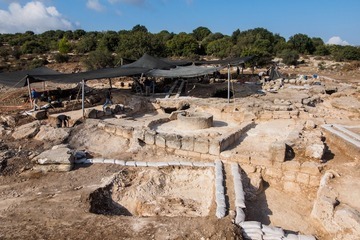 The excavation site of an ancient compound in Israel that has an oil press, winepress and mosaics dating back to the Byzantine period.
The excavation site of an ancient compound in Israel that has an oil press, winepress and mosaics dating back to the Byzantine period.
Credit: Griffin Aerial Photography Company, courtesy of the Israel Antiquities Authority
An ancient compound decorated with earth-toned mosaics may have once housed Byzantine-era monks as they pressed wine and oil for their livelihood. Archaeologists from the Israeli Antiquities Authority reported that they had uncovered the ancient compound in recent weeks.
The archaeological team found the compound in Ramat Bet Shemesh, about 19 miles (30 kilometers) west of Jerusalem. Surprisingly, the team's initial search didn't require any digging: While surveying the hills south of Bet Shemesh, the researchers discovered cisterns, a cave opening and the tops of several walls in plain sight. These clues led to a large archaeological excavation that revealed the affluent lives of people who lived at the site before the seventh century C.E. during the Byzantine period, which lasted from 330 to 1453.
The excavation unearthed a sizeable, yet organized compound with a sturdy outer wall. Its inhabitants had divided the indoor area into two regions: an industrial room and a living space. The team also found a large, well-persevered press that would have been used to make oil in the industrial room. [Image Gallery: See Arial Shots of the Byzantine Dwelling]
The compound also held a large winepress with two treading floors — an area where workers crush grapes with their feet to extract the juice — that connected to a collection vat.
These two findings, the oil press and the winepress, suggest the local residents likely produced wine and oil for a living, the researchers said in a statement. What's more, the remarkable size of the equipment suggests the residents had an industrial-scale operation rather than one for domestic use.
The residential space was divided into several rooms, some with mosaics preserved on the floor. In one room with a colorful mosaic floor, the researchers found a staircase that led to a second story of the house, which was not preserved. A mosaic in another room shows a cluster of grapes surrounded by flowers within a circle and other geometric shapes.
The team also found two ovens, likely used for baking, within the compound.
The archaeologists did not find any religious artifacts, but it's possible the compound served as a monastery during the Byzantine period, said Irene Zilberbod and Tehila libman, excavation directors on behalf of the Israel Antiquities Authority.
"It is true we did not find a church at the site or an inscription or any other unequivocal evidence of religious worship," they said in the statement. "Nevertheless, the impressive construction; the dating to the Byzantine period; the magnificent mosaic floors, window and roof tile artifacts; as well as the agricultural-industrial installations inside the dwelling compound are all known to us from numerous other contemporary monasteries."
The findings suggest the compound may have been a monastery that served as a dwelling, a workspace and a religious area used by monks, the archaeologists said.
The building likely changed hands at the beginning of the Islamic period in the seventhcentury, when its operations stopped and new residents occupied the space, the researchers said. The new owners changed the plan of the compound to fit their needs, the archaeologists found.
The Israeli government is now moving to preserve the site for future generations.
"After exposing the compound and recognizing its importance, the Israel Antiquities Authority and Ministry of Construction and Housing undertook the measures necessary for preserving and developing the site as an archaeological landmark in the heart of the new neighborhood slated to be built there," said Yuval Baruch, the Jerusalem regional archaeologist of the Israel Antiquities Authority.
The finding is the latest of many archaeological sites that provide insight into the past religious and material lives of the region's prosperous ancient inhabitants. In 2013, a team unearthed a 10,000-year-old cultic temple west of Jerusalem; that same year, the team found the remains of a wealthy estate with a garden and a mosaic fountainin central Israel dating to the late 10th and early 11th centuries.
livescience
 The excavation site of an ancient compound in Israel that has an oil press, winepress and mosaics dating back to the Byzantine period.
The excavation site of an ancient compound in Israel that has an oil press, winepress and mosaics dating back to the Byzantine period.Credit: Griffin Aerial Photography Company, courtesy of the Israel Antiquities Authority
An ancient compound decorated with earth-toned mosaics may have once housed Byzantine-era monks as they pressed wine and oil for their livelihood. Archaeologists from the Israeli Antiquities Authority reported that they had uncovered the ancient compound in recent weeks.
The archaeological team found the compound in Ramat Bet Shemesh, about 19 miles (30 kilometers) west of Jerusalem. Surprisingly, the team's initial search didn't require any digging: While surveying the hills south of Bet Shemesh, the researchers discovered cisterns, a cave opening and the tops of several walls in plain sight. These clues led to a large archaeological excavation that revealed the affluent lives of people who lived at the site before the seventh century C.E. during the Byzantine period, which lasted from 330 to 1453.
The excavation unearthed a sizeable, yet organized compound with a sturdy outer wall. Its inhabitants had divided the indoor area into two regions: an industrial room and a living space. The team also found a large, well-persevered press that would have been used to make oil in the industrial room. [Image Gallery: See Arial Shots of the Byzantine Dwelling]
The compound also held a large winepress with two treading floors — an area where workers crush grapes with their feet to extract the juice — that connected to a collection vat.
These two findings, the oil press and the winepress, suggest the local residents likely produced wine and oil for a living, the researchers said in a statement. What's more, the remarkable size of the equipment suggests the residents had an industrial-scale operation rather than one for domestic use.
The residential space was divided into several rooms, some with mosaics preserved on the floor. In one room with a colorful mosaic floor, the researchers found a staircase that led to a second story of the house, which was not preserved. A mosaic in another room shows a cluster of grapes surrounded by flowers within a circle and other geometric shapes.
The team also found two ovens, likely used for baking, within the compound.
The archaeologists did not find any religious artifacts, but it's possible the compound served as a monastery during the Byzantine period, said Irene Zilberbod and Tehila libman, excavation directors on behalf of the Israel Antiquities Authority.
"It is true we did not find a church at the site or an inscription or any other unequivocal evidence of religious worship," they said in the statement. "Nevertheless, the impressive construction; the dating to the Byzantine period; the magnificent mosaic floors, window and roof tile artifacts; as well as the agricultural-industrial installations inside the dwelling compound are all known to us from numerous other contemporary monasteries."
The findings suggest the compound may have been a monastery that served as a dwelling, a workspace and a religious area used by monks, the archaeologists said.
The building likely changed hands at the beginning of the Islamic period in the seventhcentury, when its operations stopped and new residents occupied the space, the researchers said. The new owners changed the plan of the compound to fit their needs, the archaeologists found.
The Israeli government is now moving to preserve the site for future generations.
"After exposing the compound and recognizing its importance, the Israel Antiquities Authority and Ministry of Construction and Housing undertook the measures necessary for preserving and developing the site as an archaeological landmark in the heart of the new neighborhood slated to be built there," said Yuval Baruch, the Jerusalem regional archaeologist of the Israel Antiquities Authority.
The finding is the latest of many archaeological sites that provide insight into the past religious and material lives of the region's prosperous ancient inhabitants. In 2013, a team unearthed a 10,000-year-old cultic temple west of Jerusalem; that same year, the team found the remains of a wealthy estate with a garden and a mosaic fountainin central Israel dating to the late 10th and early 11th centuries.
livescience

Published on September 20, 2014 15:43
Pharaoh-Branded Amulet Found at Ancient Copper Mine in Jordan
By Megan Gannon
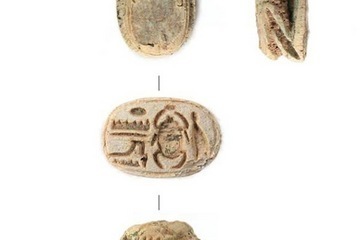 A detail of the scarab found at Khirbat Hamra Ifdan
A detail of the scarab found at Khirbat Hamra Ifdan
Credit: University of California, San Diego
While exploring ancient copper factories in southern Jordan, a team of archaeologists picked up an Egyptian amulet that bears the name of the powerful pharaoh Sheshonq I.
The tiny artifact could attest to the fabled military campaign that Sheshonq I waged in the region nearly 3,000 years ago, researchers say.
The scarab (called that because it's shaped like a scarab beetle) was found at the copper-producing site of Khirbat Hamra Ifdan in the Faynan district, some 31 miles (50 kilometers) south of the Dead Sea. The site, which was discovered during excavations in 2002, was home to intense metal production during the Early Bronze Age, between about 3000 B.C. and 2000 B.C. But there is also evidence of more recent smelting activities at Khirbat Hamra Ifdan during the Iron Age, from about 1000 B.C. to 900 B.C. [The Holy Land: 7 Amazing Archaeological Finds]
The hieroglyphic sequence on the scarab reads: "bright is the manifestation of Re, chosen of Amun/Re." That moniker corresponds to the throne name of Sheshonq I, the founding monarch of Egypt's 22nd Dynasty, who is believed to have ruled from about 945 B.C. to 924 B.C., according to a description of the artifact published online last week in the journal Antiquity.
The lead author of the paper, Thomas E. Levy, an anthropology professor at the University of California, San Diego, said the function of scarabs changed throughout Egypt's history.
"Most of the time, they were amulets, sometimes jewelry, and periodically, they were inscribed for use as personal or administrative seals," Levy said in a statement. "We think this is the case with the Sheshonq I scarab we found."
The scarab wasn't found during excavations; rather a grad student picked it up from the surface of the ground while Levy was giving a tour of the smelting slags at Khirbat Hamra Ifdan. Though the artifact was not discovered in its original archaeological context, it could provide evidence for the extent of Sheshonq I's legendary military campaign in this mineral-rich region, Levy and colleagues said.
The discovery of the scarab dredges up an old controversy over the date of the southern Levant's ancient copper mines — and their ties to biblical events.
In the 1930s, American rabbi and archaeologist Nelson Glueck claimed he found King Solomon's fabled mines when he discovered copper production sites in the region. But in the years that followed, archaeologists became more wary of how much they could use biblical accounts to guide their interpretations. In the 1970s and 1980s, archaeologists who excavated in southern Jordan argued that the Iron Age did not begin there until the seventh century B.C. — much later than the 10th century B.C. reign of King Solomon.
However, in a 2008 study in the journal Proceedings of the National Academy of Sciences, Levy and colleagues used radiocarbon dating to show that artifacts at Khirbat en-Nahas — another ancient copper mining and smelting site in the Faynan that's so huge it can be seen from space — were actually as old as the 10th century B.C.
"In my opinion, the debate over dating copper production in the Faynan region is over," Levy told Live Science in an email. "We produced over 130 high-precision radiocarbon dates for the main production sites and a range of other data. As for Solomon, without inscriptions, we still don't know who controlled the copper production at this time for sure."
But now, they apparenly have inscriptions linking the region to Sheshonq I. In the 2008 study, Levy and colleagues had identified a major disruption in industrial copper production in Faynan during the 10th century B.C., which they attributed to Sheshonq I's military campaign.
The Hebrew Bible references the exploits of the Egyptian king "Shishak" — thought to be Sheshonq I. The Egyptian king was said to have invaded the region five years after King Solomon's death in 931 B.C., conquering cities in Jezreel Valley and the Negev area and even marching on Jerusalem. Inscriptions at the Karnak temple complex in the ancient Egyptian city of Thebes also brag about Sheshonq I's military campaign in the region.
Levy and colleagues previously found scarabs in Khirbat en-Nahas that resembled popular amulets from Sheshonq I's reign. But the new scarab contains the first written evidence the researchers have to link the disruption to the pharaoh's forces, Levy said.
livescience
 A detail of the scarab found at Khirbat Hamra Ifdan
A detail of the scarab found at Khirbat Hamra IfdanCredit: University of California, San Diego
While exploring ancient copper factories in southern Jordan, a team of archaeologists picked up an Egyptian amulet that bears the name of the powerful pharaoh Sheshonq I.
The tiny artifact could attest to the fabled military campaign that Sheshonq I waged in the region nearly 3,000 years ago, researchers say.
The scarab (called that because it's shaped like a scarab beetle) was found at the copper-producing site of Khirbat Hamra Ifdan in the Faynan district, some 31 miles (50 kilometers) south of the Dead Sea. The site, which was discovered during excavations in 2002, was home to intense metal production during the Early Bronze Age, between about 3000 B.C. and 2000 B.C. But there is also evidence of more recent smelting activities at Khirbat Hamra Ifdan during the Iron Age, from about 1000 B.C. to 900 B.C. [The Holy Land: 7 Amazing Archaeological Finds]
The hieroglyphic sequence on the scarab reads: "bright is the manifestation of Re, chosen of Amun/Re." That moniker corresponds to the throne name of Sheshonq I, the founding monarch of Egypt's 22nd Dynasty, who is believed to have ruled from about 945 B.C. to 924 B.C., according to a description of the artifact published online last week in the journal Antiquity.
The lead author of the paper, Thomas E. Levy, an anthropology professor at the University of California, San Diego, said the function of scarabs changed throughout Egypt's history.
"Most of the time, they were amulets, sometimes jewelry, and periodically, they were inscribed for use as personal or administrative seals," Levy said in a statement. "We think this is the case with the Sheshonq I scarab we found."
The scarab wasn't found during excavations; rather a grad student picked it up from the surface of the ground while Levy was giving a tour of the smelting slags at Khirbat Hamra Ifdan. Though the artifact was not discovered in its original archaeological context, it could provide evidence for the extent of Sheshonq I's legendary military campaign in this mineral-rich region, Levy and colleagues said.
The discovery of the scarab dredges up an old controversy over the date of the southern Levant's ancient copper mines — and their ties to biblical events.
In the 1930s, American rabbi and archaeologist Nelson Glueck claimed he found King Solomon's fabled mines when he discovered copper production sites in the region. But in the years that followed, archaeologists became more wary of how much they could use biblical accounts to guide their interpretations. In the 1970s and 1980s, archaeologists who excavated in southern Jordan argued that the Iron Age did not begin there until the seventh century B.C. — much later than the 10th century B.C. reign of King Solomon.
However, in a 2008 study in the journal Proceedings of the National Academy of Sciences, Levy and colleagues used radiocarbon dating to show that artifacts at Khirbat en-Nahas — another ancient copper mining and smelting site in the Faynan that's so huge it can be seen from space — were actually as old as the 10th century B.C.
"In my opinion, the debate over dating copper production in the Faynan region is over," Levy told Live Science in an email. "We produced over 130 high-precision radiocarbon dates for the main production sites and a range of other data. As for Solomon, without inscriptions, we still don't know who controlled the copper production at this time for sure."
But now, they apparenly have inscriptions linking the region to Sheshonq I. In the 2008 study, Levy and colleagues had identified a major disruption in industrial copper production in Faynan during the 10th century B.C., which they attributed to Sheshonq I's military campaign.
The Hebrew Bible references the exploits of the Egyptian king "Shishak" — thought to be Sheshonq I. The Egyptian king was said to have invaded the region five years after King Solomon's death in 931 B.C., conquering cities in Jezreel Valley and the Negev area and even marching on Jerusalem. Inscriptions at the Karnak temple complex in the ancient Egyptian city of Thebes also brag about Sheshonq I's military campaign in the region.
Levy and colleagues previously found scarabs in Khirbat en-Nahas that resembled popular amulets from Sheshonq I's reign. But the new scarab contains the first written evidence the researchers have to link the disruption to the pharaoh's forces, Levy said.
livescience

Published on September 20, 2014 15:34
700-Year Embrace: Skeleton Couple Still Holding Hands
Laura Geggel
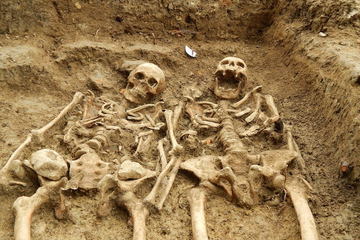 These lovebirds have held hands for the past 700 years.
These lovebirds have held hands for the past 700 years.
Credit: University of Leicester Archaeological Services
The skeletal remains of two lovebirds were uncovered, after being locked in a romantic embrace for the past 700 years.
Archeologists found the happy couple holding hands in an earthen grave during an excavation of a "lost" chapel in Leicestershire, England, researchers reported Thursday (Sept. 18).
"We have seen similar skeletons before from Leicester where a couple has been buried together in a single grave," Vicki Score, University of Leicester Archaeological Services (ULAS) project manager, said in a statement.
Double graves are not that unusual. But it's surprising that the two bodies were buried at the so-called "lost" chapel of St Morrell, only recently discovered by a local historian and a team of researchers, instead of at the local church. [8 Grisly Archaeological Discoveries]
"The main question we find ourselves asking is why were they buried up there? There is a perfectly good church in Hallaton," Score said. "This leads us to wonder if the chapel could have served as some sort of special place of burial at the time."
For example, the site may have served as a place of pilgrimage in Hallaton, a village in east Leicestershire, during the 14th century, the researchers said. Or, the couple may have been buried at the Chapel of St Morrell, and not in the main church, because they were criminals, foreigners or diseased.
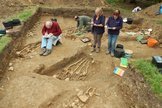 [image error] Archeologists and volunteers take notes during the excavation of the chapel and cemetery.
[image error] Archeologists and volunteers take notes during the excavation of the chapel and cemetery.
Credit: University of Leicester Archaeological ServicesView full size imageULAS archaeologists and local volunteers have spent the past four years uncovering the lost chapel of St Morrell, near the village of Hallaton. The team has found evidence that the use of the hillside extends back to Roman times, more than 2,000 years ago.
For instance, a square ditch at the site indicates that the hilltop may have once held a Roman temple. The team also found an Iron Age shrine with thousands of coins and silver artifacts, such as a Roman cavalry helmet.
Excavations now show the chapel's walls and tiled floor, along with pieces of stone masonry, wall plaster, tiles, lead from the windows and a nearby cemetery. Archaeologists have also found money among the ruins, including several silver pennies. These coins, which date back to between the 12th and 16th centuries, have helped researchers determine the chapel's most active years.
Through the process of radiocarbon dating, the archaeologists determined that 11 skeletons so far excavated from the site date back to the 14th century. All of the skeletons found at the chapel site were laid in an east-west orientation, per Christian tradition at that time.
livescience
 These lovebirds have held hands for the past 700 years.
These lovebirds have held hands for the past 700 years.Credit: University of Leicester Archaeological Services
The skeletal remains of two lovebirds were uncovered, after being locked in a romantic embrace for the past 700 years.
Archeologists found the happy couple holding hands in an earthen grave during an excavation of a "lost" chapel in Leicestershire, England, researchers reported Thursday (Sept. 18).
"We have seen similar skeletons before from Leicester where a couple has been buried together in a single grave," Vicki Score, University of Leicester Archaeological Services (ULAS) project manager, said in a statement.
Double graves are not that unusual. But it's surprising that the two bodies were buried at the so-called "lost" chapel of St Morrell, only recently discovered by a local historian and a team of researchers, instead of at the local church. [8 Grisly Archaeological Discoveries]
"The main question we find ourselves asking is why were they buried up there? There is a perfectly good church in Hallaton," Score said. "This leads us to wonder if the chapel could have served as some sort of special place of burial at the time."
For example, the site may have served as a place of pilgrimage in Hallaton, a village in east Leicestershire, during the 14th century, the researchers said. Or, the couple may have been buried at the Chapel of St Morrell, and not in the main church, because they were criminals, foreigners or diseased.
 [image error] Archeologists and volunteers take notes during the excavation of the chapel and cemetery.
[image error] Archeologists and volunteers take notes during the excavation of the chapel and cemetery.Credit: University of Leicester Archaeological ServicesView full size imageULAS archaeologists and local volunteers have spent the past four years uncovering the lost chapel of St Morrell, near the village of Hallaton. The team has found evidence that the use of the hillside extends back to Roman times, more than 2,000 years ago.
For instance, a square ditch at the site indicates that the hilltop may have once held a Roman temple. The team also found an Iron Age shrine with thousands of coins and silver artifacts, such as a Roman cavalry helmet.
Excavations now show the chapel's walls and tiled floor, along with pieces of stone masonry, wall plaster, tiles, lead from the windows and a nearby cemetery. Archaeologists have also found money among the ruins, including several silver pennies. These coins, which date back to between the 12th and 16th centuries, have helped researchers determine the chapel's most active years.
Through the process of radiocarbon dating, the archaeologists determined that 11 skeletons so far excavated from the site date back to the 14th century. All of the skeletons found at the chapel site were laid in an east-west orientation, per Christian tradition at that time.
livescience

Published on September 20, 2014 15:27
September 19, 2014
The Spirits of Maine Series by Lydia North
Creepy Ghost Stories from the coast of Maine! Get The Spirits of Maine Series... and maybe a nightlight too.

Lilies in the Clearing
This is the sequel to Waiting for Harvey.
Erik Rivard survived his time in the cabin with the ghost of Harvey Cloutier.
Now he's going back to the clearing.
Harvey is a strong Spirit of the Maine Woods.
But this time Erik won't be alone. Can he survive another encounter with Harvey?
Waiting for Harvey
Erik went into the woods of northern Maine for a vacation. He planned to enjoy three weeks of quiet serenity. But in the cabin nothing was what he expected and his life would never be the same.
As winter settles over the region Erik begins to question whether he will get away from the woods alive.
The woods of Maine belong to the spirits who live there. When the whispering begins... RUN!
Amazon Links


Lilies in the Clearing
This is the sequel to Waiting for Harvey.
Erik Rivard survived his time in the cabin with the ghost of Harvey Cloutier.
Now he's going back to the clearing.
Harvey is a strong Spirit of the Maine Woods.
But this time Erik won't be alone. Can he survive another encounter with Harvey?
Waiting for Harvey
Erik went into the woods of northern Maine for a vacation. He planned to enjoy three weeks of quiet serenity. But in the cabin nothing was what he expected and his life would never be the same.
As winter settles over the region Erik begins to question whether he will get away from the woods alive.
The woods of Maine belong to the spirits who live there. When the whispering begins... RUN!
Amazon Links

Published on September 19, 2014 05:01
History Trivia - Battle of Poitiers - Edward, the Black Prince captures the French king, John II.
Sept 19
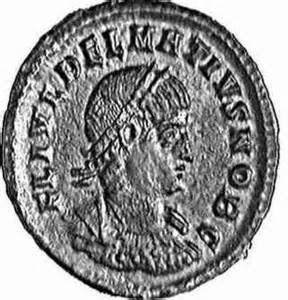
335 Dalmatius was raised to the rank of Caesar by his uncle Constantine I.

912 Emperor Leo VI was born. Known as the Wise or the Philosopher, Emperor Leo VI of Byzantium issued imperial laws in Greek that became the legal code of the Empire.
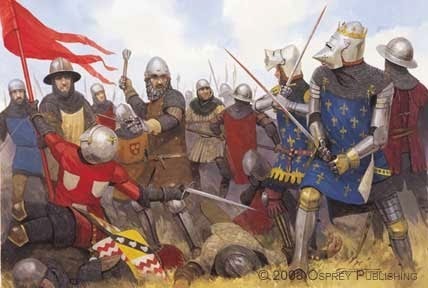
1356 Hundred Years' War: Battle of Poitiers: an English army under the command of Edward, the Black Prince defeated a French army and captured the French king, John II.


335 Dalmatius was raised to the rank of Caesar by his uncle Constantine I.

912 Emperor Leo VI was born. Known as the Wise or the Philosopher, Emperor Leo VI of Byzantium issued imperial laws in Greek that became the legal code of the Empire.

1356 Hundred Years' War: Battle of Poitiers: an English army under the command of Edward, the Black Prince defeated a French army and captured the French king, John II.

Published on September 19, 2014 05:00
September 18, 2014
History Trivia - Marcus Nerva proclaimed Roman Emperor
Sept 18

53 Roman Emperor Trajan was born.
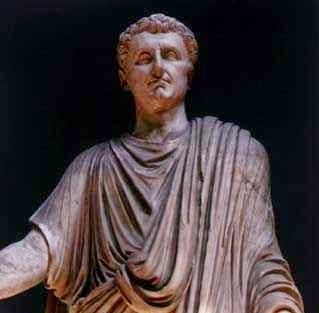
96 Marcus Nerva was proclaimed Roman Emperor after Domitian was assassinated.
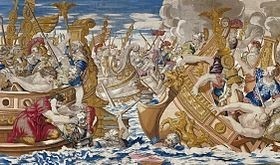
324 Constantine the Great decisively defeated Licinius in the Battle of Chrysopolis, establishing Constantine's sole control over the Roman Empire. 1

180 Philip Augustus became king of France. Philip was one of the most successful medieval French monarchs in expanding the royal demesne and the influence of the monarchy. He broke up the great Angevin Empire (an area stretching from the Pyrenees to Ireland ruled by the Angevin Plantagenet dynasty during the 12th and early 13th centuries) and defeated a coalition of his rivals (German, Flemish and English) at the Battle of Bouvines in 1214.


53 Roman Emperor Trajan was born.

96 Marcus Nerva was proclaimed Roman Emperor after Domitian was assassinated.

324 Constantine the Great decisively defeated Licinius in the Battle of Chrysopolis, establishing Constantine's sole control over the Roman Empire. 1

180 Philip Augustus became king of France. Philip was one of the most successful medieval French monarchs in expanding the royal demesne and the influence of the monarchy. He broke up the great Angevin Empire (an area stretching from the Pyrenees to Ireland ruled by the Angevin Plantagenet dynasty during the 12th and early 13th centuries) and defeated a coalition of his rivals (German, Flemish and English) at the Battle of Bouvines in 1214.

Published on September 18, 2014 05:27
September 17, 2014
Richard III died in battle after losing helmet, new research shows

Link to video: Richard III: how the king was killed in battle
Richard III died in the thick of battle after losing his helmet and coming under a hail of blows from vicious medieval weapons, new research has shown. Detailed scans of the king's bones show that he sustained 11 wounds at or near the time of his death, nine of them to the skull.
The blows to the head were clearly inflicted in battle and suggest that he was not wearing his helmet.
There was another potentially fatal injury to the pelvis that may have been inflicted after death.
Professor Guy Rutty, from the University of Leicester, said: "The most likely injuries to have caused the king's death are the two to the inferior aspect of the skull – a large sharp force trauma possibly from a sword or staff weapon, such as a halberd or bill, and a penetrating injury from the tip of an edged weapon.
"Richard's head injuries are consistent with some near-contemporary accounts of the battle, which suggest that Richard abandoned his horse after it became stuck in a mire and was killed while fighting his enemies."
Richard III, the last English monarch to die fighting, perished at the Battle of Bosworth in 1485. It was the last significant battle of the Wars of the Roses, the civil war between the Houses of Lancaster and York, and paved the way for the Tudor dynasty.
Scientists and historians have been studying the king's remains since his skeleton was found under a car park in Leicester.
Evidence suggests he was not the hunchbacked, deformed monstrosity depicted by William Shakespeare.
Experts now know he had a bent spine with a "well balanced curve" that could easily have been concealed by clothing and would not have affected his prowess in battle. He probably did not walk with a limp.
The latest research, published in The Lancet medical journal's online edition, involved whole body CT (computed tomography) X-ray scans and micro-CT imaging.
Marks left on the bones by weapons were also analysed.
The serious injury to the pelvis should have been prevented by Richard's armour, according to the researchers. They speculate that it might have been inflicted after death, with the armour removed.
Co-author Professor Sarah Hainsworth, also from the University of Leicester, said: "Richard's injuries represent a sustained attack or an attack by several assailants with weapons from the later medieval period.
"The wounds to the skull suggest that he was not wearing a helmet, and the absence of defensive wounds on his arms and hands indicate that he was otherwise still armoured at the time of his death."
Commenting on the study, Dr Heather Bonney from the Natural History Museum in London said the research provided a "compelling account" of the way Richard III met his death.
She added: "Wherever his remains are again laid to rest, I am sure that Richard III will continue to divide opinion fiercely for centuries to come."
The Guardian

Published on September 17, 2014 14:23
Historic 'Ghost Ships' Discovered Near Golden Gate Bridge
By Megan Gannon
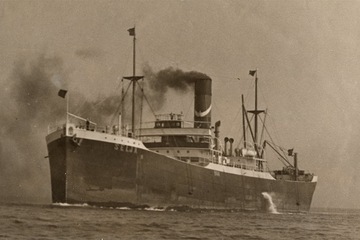 This huge ship now rests on the bottom of the Gulf of the Farallones, just west of San Francisco. Named Selja, it sank in 1910 after a collision with another ship.
This huge ship now rests on the bottom of the Gulf of the Farallones, just west of San Francisco. Named Selja, it sank in 1910 after a collision with another ship.
Credit: San Francisco Maritime National Historical Park
The waters just west of San Francisco's Golden Gate Bridge hide a graveyard of sunken ships. By some estimates, there are 300 wrecks in the Gulf of the Farallones National Marine Sanctuary and the Golden Gate National Recreation Area alone. But only a fraction of them have been seen by scientists.
Marine archaeologists and researchers with the National Oceanic and Atmospheric Administration (NOAA) have set out to document those lost vessels. Over the course of a five-day survey that just ended yesterday (Sept. 15), the team discovered the sites of at least four wrecks: the 1910 SS Selja shipwreck, the 1863 wreck of the clipper ship Noonday and two unidentified wrecks.
"We're looking at an area that was a funnel to the busiest and most important American port on the Pacific Coast," said James Delgado, director of Maritime Heritage for the Office of National Marine Sanctuaries. The wrecks in the Gulf of the Farallones span a huge chunk of history, from 1595 to the present. Perhaps the best-known recent example is the tanker Puerto Rican, which exploded and sank off San Francisco in 1984. [See Photos of the Sunken Ships Near San Francisco]
Delgado told Live Science that the team used a remotely operated vehicle, or ROV, to assess eight spots that had intriguing sonar signals. Four of of those sites turned out to have shipwrecks.
One of the newly located wrecks, the SS Selja steam freighter, was a workhorse that carried goods between the Pacific Northwest and China and Japan. On Nov. 22, 1910, the 380-foot-long (116 meters) vessel sank after it collided with a steamer named Beaver off Point Reyes, California. The Master of Selja, Olaf Lie, tried suing the Beaver and its owners for the loss of the ship, but the maritime court ruled against Lie, claiming he had been going too fast in a thick fog and was responsible, according to NOAA.
A volunteer who reanalyzed a cache of NOAA sonar data found a signal that was the right size and in the right location to be the clipper ship Noonday. The vessel had brought men and supplies to California during and after the Gold Rush. On New Year's Day in 1863, after a 139-day journey from Boston, the Noonday struck a rock just as it was approaching its destination, the San Francisco harbor. It quickly took on water and sank. Today, the vessel is obscured by mud.

[image error] The blip in this sonar image is the clipper ship Noonday, which sank in 1863 after hitting a rock just outside of San Francisco harbor.
Credit: NOAA
View full size imageThe team also discovered one badly broken-up wreck covered in fishnets and a rather intact tugboat where no wreck was expected to be found, Delgado said. "We have a little homework to do there," he added.
NOAA additionally completed the first sonar survey of the wrecks of the tankers Frank H. Buck and Lyman Stewart, which were both loaded with oil when they ran aground in 1937 and 1922, respectively, after collisions with other vessels in thick fog. The engines from both shipwrecks are visible today when the tide goes out off San Francisco's Lands End park.
NOAA has created an online inventory of underwater footage, sonar images, historic photographs and documents related to the wrecks that have been located.
Live Science

 This huge ship now rests on the bottom of the Gulf of the Farallones, just west of San Francisco. Named Selja, it sank in 1910 after a collision with another ship.
This huge ship now rests on the bottom of the Gulf of the Farallones, just west of San Francisco. Named Selja, it sank in 1910 after a collision with another ship.Credit: San Francisco Maritime National Historical Park
The waters just west of San Francisco's Golden Gate Bridge hide a graveyard of sunken ships. By some estimates, there are 300 wrecks in the Gulf of the Farallones National Marine Sanctuary and the Golden Gate National Recreation Area alone. But only a fraction of them have been seen by scientists.
Marine archaeologists and researchers with the National Oceanic and Atmospheric Administration (NOAA) have set out to document those lost vessels. Over the course of a five-day survey that just ended yesterday (Sept. 15), the team discovered the sites of at least four wrecks: the 1910 SS Selja shipwreck, the 1863 wreck of the clipper ship Noonday and two unidentified wrecks.
"We're looking at an area that was a funnel to the busiest and most important American port on the Pacific Coast," said James Delgado, director of Maritime Heritage for the Office of National Marine Sanctuaries. The wrecks in the Gulf of the Farallones span a huge chunk of history, from 1595 to the present. Perhaps the best-known recent example is the tanker Puerto Rican, which exploded and sank off San Francisco in 1984. [See Photos of the Sunken Ships Near San Francisco]
Delgado told Live Science that the team used a remotely operated vehicle, or ROV, to assess eight spots that had intriguing sonar signals. Four of of those sites turned out to have shipwrecks.
One of the newly located wrecks, the SS Selja steam freighter, was a workhorse that carried goods between the Pacific Northwest and China and Japan. On Nov. 22, 1910, the 380-foot-long (116 meters) vessel sank after it collided with a steamer named Beaver off Point Reyes, California. The Master of Selja, Olaf Lie, tried suing the Beaver and its owners for the loss of the ship, but the maritime court ruled against Lie, claiming he had been going too fast in a thick fog and was responsible, according to NOAA.
A volunteer who reanalyzed a cache of NOAA sonar data found a signal that was the right size and in the right location to be the clipper ship Noonday. The vessel had brought men and supplies to California during and after the Gold Rush. On New Year's Day in 1863, after a 139-day journey from Boston, the Noonday struck a rock just as it was approaching its destination, the San Francisco harbor. It quickly took on water and sank. Today, the vessel is obscured by mud.

[image error] The blip in this sonar image is the clipper ship Noonday, which sank in 1863 after hitting a rock just outside of San Francisco harbor.
Credit: NOAA
View full size imageThe team also discovered one badly broken-up wreck covered in fishnets and a rather intact tugboat where no wreck was expected to be found, Delgado said. "We have a little homework to do there," he added.
NOAA additionally completed the first sonar survey of the wrecks of the tankers Frank H. Buck and Lyman Stewart, which were both loaded with oil when they ran aground in 1937 and 1922, respectively, after collisions with other vessels in thick fog. The engines from both shipwrecks are visible today when the tide goes out off San Francisco's Lands End park.
NOAA has created an online inventory of underwater footage, sonar images, historic photographs and documents related to the wrecks that have been located.
Live Science

Published on September 17, 2014 14:16
Tiny Bite Marks Reveal Afterlife of an Ichthyosaur
By Megan Gannon
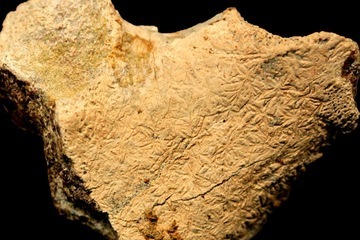 At least 145 million years ago, a hungry sea urchin might have left these star-shaped marks on this rib fragment of an ichthyosaur.
At least 145 million years ago, a hungry sea urchin might have left these star-shaped marks on this rib fragment of an ichthyosaur.
Credit: Nature Communications, doi:10.1038/ncomms5789
When whales die, their bodies sink to the seafloor. But surprisingly few of their natural graves have ever been found.
The rare "whale falls" that have been seen by scientists aren't exactly grim pictures of death; rather, they're often teeming with life. Sharks, eels, bacteria and bone-eating "zombie worms" gather around these nutrient-rich graveyards. The number of new species discovered around whale falls in deep water suggests the carcasses can host distinct, complex ecosystems.
At a time when dinosaurs still roamed Earth and whales and other marine mammals had yet to evolve, the corpses of marine reptiles known as ichthyosaurs may have enriched the seas, according to a new study. [Image Gallery: Ancient Monsters of the Sea]
A group of scientists reports they found traces of scavenging on the bones from a fossilized "ichthyosaur fall" of the Late Jurassic Period. This 10-foot-long (3 meters) specimen was discovered during the construction of a road in 1991 in Dorset, England. (The creature is now housed at the Bristol City Museum and Art Gallery.)
Ichthyosaurs, which lived from about 245 million to 90 million years ago, were dolphin-shaped predators that gave birth to live young. The one that turned up in Dorset belonged to the genus Ophthalmosaurus, named so for the animal's freakishly big eyes.
The researchers — led by Silvia Danise of Plymouth University in the United Kingdom — found sharp, narrow grooves on the animal's rib bones, likely left by small fish that picked flesh off the ichthyosaur soon after it died. The scientists also saw star-shaped grazing marks likely left by sea urchins that flocked to the boneyard once it was covered in bacteria. The carcass then seems to have gone through a "reef stage" for several years when the bones were encrusted by animals like oysters.
Modern whale falls typically don't go through a long reef stage, partly because bone-eating worms in the genus Osedax can devour an entire whale skeleton within a few years, Danise and colleagues wrote on Sept. 10 in the journal Nature Communications. But this ichthyosaur was likely spared. Scientists currently believe Osedax worms, which were only described in 2002, evolved in the late Cretaceous Period — millions of years after this ichthyosaur met its death.
Live Science

 At least 145 million years ago, a hungry sea urchin might have left these star-shaped marks on this rib fragment of an ichthyosaur.
At least 145 million years ago, a hungry sea urchin might have left these star-shaped marks on this rib fragment of an ichthyosaur.Credit: Nature Communications, doi:10.1038/ncomms5789
When whales die, their bodies sink to the seafloor. But surprisingly few of their natural graves have ever been found.
The rare "whale falls" that have been seen by scientists aren't exactly grim pictures of death; rather, they're often teeming with life. Sharks, eels, bacteria and bone-eating "zombie worms" gather around these nutrient-rich graveyards. The number of new species discovered around whale falls in deep water suggests the carcasses can host distinct, complex ecosystems.
At a time when dinosaurs still roamed Earth and whales and other marine mammals had yet to evolve, the corpses of marine reptiles known as ichthyosaurs may have enriched the seas, according to a new study. [Image Gallery: Ancient Monsters of the Sea]
A group of scientists reports they found traces of scavenging on the bones from a fossilized "ichthyosaur fall" of the Late Jurassic Period. This 10-foot-long (3 meters) specimen was discovered during the construction of a road in 1991 in Dorset, England. (The creature is now housed at the Bristol City Museum and Art Gallery.)
Ichthyosaurs, which lived from about 245 million to 90 million years ago, were dolphin-shaped predators that gave birth to live young. The one that turned up in Dorset belonged to the genus Ophthalmosaurus, named so for the animal's freakishly big eyes.
The researchers — led by Silvia Danise of Plymouth University in the United Kingdom — found sharp, narrow grooves on the animal's rib bones, likely left by small fish that picked flesh off the ichthyosaur soon after it died. The scientists also saw star-shaped grazing marks likely left by sea urchins that flocked to the boneyard once it was covered in bacteria. The carcass then seems to have gone through a "reef stage" for several years when the bones were encrusted by animals like oysters.
Modern whale falls typically don't go through a long reef stage, partly because bone-eating worms in the genus Osedax can devour an entire whale skeleton within a few years, Danise and colleagues wrote on Sept. 10 in the journal Nature Communications. But this ichthyosaur was likely spared. Scientists currently believe Osedax worms, which were only described in 2002, evolved in the late Cretaceous Period — millions of years after this ichthyosaur met its death.
Live Science

Published on September 17, 2014 14:10
Enormous New Dinosaur as Formidable as Its Namesake Battleship
At 60 tons, the newly named "Dreadnoughtus" is the most complete of the giant titanosaurs yet found.
 Ken Lacovara is shown with 22 tail vertebrae (out of 32 collected) of the massive sauropod Dreadnoughtus schrani. The dinosaur has the largest calculable weight of any known land animal.
Ken Lacovara is shown with 22 tail vertebrae (out of 32 collected) of the massive sauropod Dreadnoughtus schrani. The dinosaur has the largest calculable weight of any known land animal.Photograph by Robert Clark, Excel Magazine, Drexel University
Brian Switek
After nine years of excavation and study, paleontologists have unveiled one of the largest creatures ever to walk the Earth. The most complete skeleton of a giant titanosaur will provide new insights into how these giants lived large.
The new dinosaur is named Dreadnoughtus schrani, a reference to the armored battleship and a tribute to the dinosaur's perceived fearlessness. Details on the dinosaur are announced Thursday in the journal Scientific Reports .
 Art: Emily M. Eng, NG Staff Source: Matthew C. Lamanna, Carnegie Museum of Natural HistoryIn life, Dreadnoughtus would have been about 86 feet (26 meters) long and weigh nearly 60 tons, heavier than a Chieftan tank, Drexel University paleontologist Ken Lacovara and colleagues calculate. That's so big, the scientists write, that adults of the species would have been "nearly impervious to attack" by predators that stalked the same floodplains between 84 million and 66 million years ago.
Art: Emily M. Eng, NG Staff Source: Matthew C. Lamanna, Carnegie Museum of Natural HistoryIn life, Dreadnoughtus would have been about 86 feet (26 meters) long and weigh nearly 60 tons, heavier than a Chieftan tank, Drexel University paleontologist Ken Lacovara and colleagues calculate. That's so big, the scientists write, that adults of the species would have been "nearly impervious to attack" by predators that stalked the same floodplains between 84 million and 66 million years ago.Among the largest of dinosaurs, titanosaurs like Dreadnoughtus were hefty herbivores with tiny heads, long necks, and tapering tails. This body type marks titanosaurs as part of a group called sauropods, to which classic dinosaurs such as Apatosaurus also belonged. Sauropods spent their days feeding high and low, plucking greens from patches of ferns and trees alike, as they browsed the prehistoric salad bar.What makes Dreadnoughtus a remarkable new addition to this prehistoric family is the amount of material recovered from the dinosaur. The remains, representing two individual animals, include both the humerus and femur of Dreadnoughtus, and Lacovara and colleagues used the circumference of these bones to estimate the dinosaur's weight.So far, Lacovara says, "Dreadnoughtus has the largest calculable mass of any land animal."
 The humerus, or upper arm bone, of Dreadnoughtus shows muscle scarring.Photograph by Robert Clark, Excel Magazine, Drexel UniversityA Big FindAt first, though, Dreadnoughtus didn't seem so impressive. "In 2005, we were prospecting in the desert [of southern Argentina]," Lacovara says, "and the first day of that field season I found a collection of bones." They just looked like a pile of fragments, but when Lacovara and collaborators returned to the site, they started uncovering big limb bones."By the end of the day we had ten bones exposed," Lacovara says. "At that point we were pretty excited." Four field seasons later, the team had excavated 145 bones.Altogether the bones represent about 45 percent of a complete skeleton, and because some of the bones have mirror images on the other side of the body, Lacovara and colleagues were able to reconstruct about 70 percent of a Dreadnoughtus skeleton. The best large titanosaur find previously,
Futalognkosaurus
, was only about 27 percent complete."Now we can start talking intelligently about the body proportions of these giant titanosaurs," says Western University of Health Sciences paleontologist Mathew Wedel.
The humerus, or upper arm bone, of Dreadnoughtus shows muscle scarring.Photograph by Robert Clark, Excel Magazine, Drexel UniversityA Big FindAt first, though, Dreadnoughtus didn't seem so impressive. "In 2005, we were prospecting in the desert [of southern Argentina]," Lacovara says, "and the first day of that field season I found a collection of bones." They just looked like a pile of fragments, but when Lacovara and collaborators returned to the site, they started uncovering big limb bones."By the end of the day we had ten bones exposed," Lacovara says. "At that point we were pretty excited." Four field seasons later, the team had excavated 145 bones.Altogether the bones represent about 45 percent of a complete skeleton, and because some of the bones have mirror images on the other side of the body, Lacovara and colleagues were able to reconstruct about 70 percent of a Dreadnoughtus skeleton. The best large titanosaur find previously,
Futalognkosaurus
, was only about 27 percent complete."Now we can start talking intelligently about the body proportions of these giant titanosaurs," says Western University of Health Sciences paleontologist Mathew Wedel. Emily M. Eng, NG StaffAnd Dreadnoughtus could have grown even bigger than the new estimate. "Since the authors provide data that illustrate that Dreadnoughtus was still growing when it died," says Macalester College paleontologist Kristi Curry Rogers, "we can be fairly certain that there were other heavier dinosaurs out there."Mysterious LivesBut size isn't everything. "If we want to really begin to understand how these big dinosaurs grew, and how long it took them to reach their massive sizes, these are the perfect kinds of data to begin with," Curry Rogers says. Having two individuals is a good start, she says, but scientists will need to find more of the dinosaurs to begin piecing together their lifestyles."There are so many fundamental things we don't know about sauropods," Lacovara says, such as the arrangement of their muscles and how they moved. Turning to muscle scars on the bones of Dreadnoughtus, Lacovara and others are figuring out the dinosaur's muscle anatomy and how those soft tissues translated to movement.This is just the sort of effort other paleontologists are hoping to see. "It's all about building toward a more complete picture of the living animal," Wedel says.
Emily M. Eng, NG StaffAnd Dreadnoughtus could have grown even bigger than the new estimate. "Since the authors provide data that illustrate that Dreadnoughtus was still growing when it died," says Macalester College paleontologist Kristi Curry Rogers, "we can be fairly certain that there were other heavier dinosaurs out there."Mysterious LivesBut size isn't everything. "If we want to really begin to understand how these big dinosaurs grew, and how long it took them to reach their massive sizes, these are the perfect kinds of data to begin with," Curry Rogers says. Having two individuals is a good start, she says, but scientists will need to find more of the dinosaurs to begin piecing together their lifestyles."There are so many fundamental things we don't know about sauropods," Lacovara says, such as the arrangement of their muscles and how they moved. Turning to muscle scars on the bones of Dreadnoughtus, Lacovara and others are figuring out the dinosaur's muscle anatomy and how those soft tissues translated to movement.This is just the sort of effort other paleontologists are hoping to see. "It's all about building toward a more complete picture of the living animal," Wedel says. The 5.6-foot (1.7-meter) scapula of Dreadnoughtus is the longest yet reported for any titanosaur.Photograph by Robert Clark, Excel Magazine, Drexel UniversityFor now, though, Lacovara is glad to see Dreadnoughtus finally emerge after all the years of fieldwork and study. "This is like Christmas and my birthday and my wedding combined." National Geographic
The 5.6-foot (1.7-meter) scapula of Dreadnoughtus is the longest yet reported for any titanosaur.Photograph by Robert Clark, Excel Magazine, Drexel UniversityFor now, though, Lacovara is glad to see Dreadnoughtus finally emerge after all the years of fieldwork and study. "This is like Christmas and my birthday and my wedding combined." National Geographic

Published on September 17, 2014 14:05



